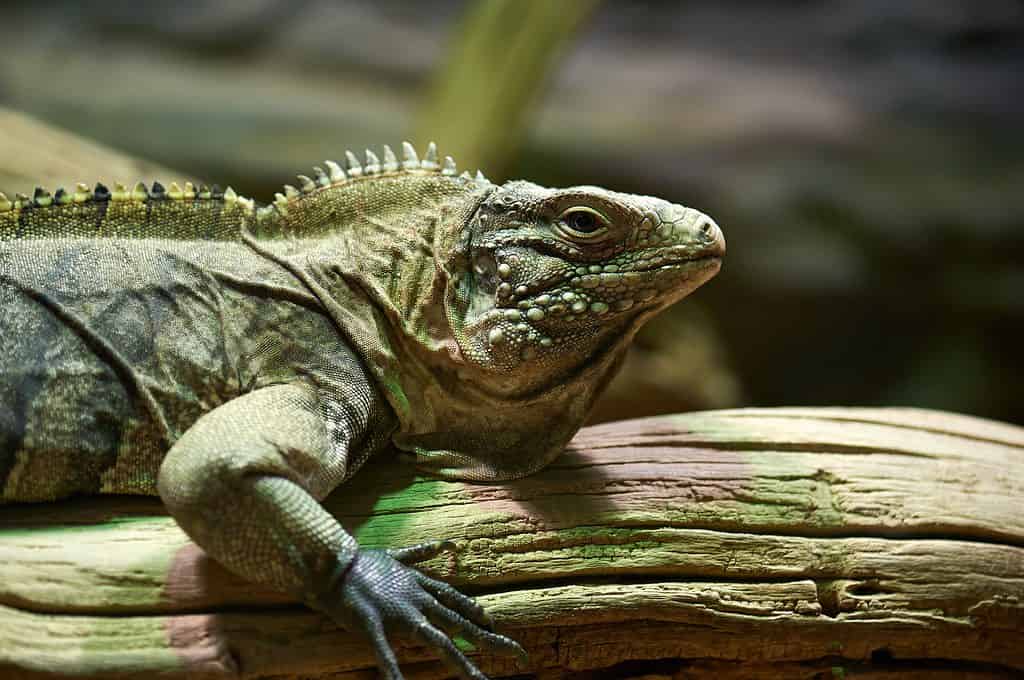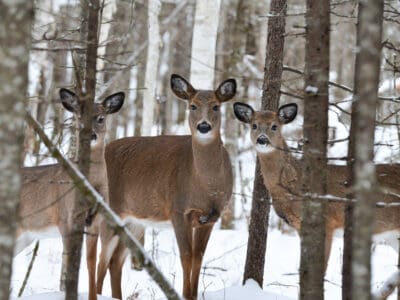Jamaican Iguana
Cyclura collei
Almost went extinct for 40 years
Advertisement
Jamaican Iguana Scientific Classification
- Kingdom
- Animalia
- Phylum
- Chordata
- Class
- Reptilia
- Order
- Squamata
- Family
- Iguanidae
- Genus
- Cyclura
- Scientific Name
- Cyclura collei
Read our Complete Guide to Classification of Animals.
Jamaican Iguana Conservation Status
Jamaican Iguana Facts
- Prey
- Insects and invertebrates
- Name Of Young
- Hatchling
- Group Behavior
- Social
- Fun Fact
- Almost went extinct for 40 years
- Estimated Population Size
- 100-200
- Biggest Threat
- Habitat loss and predation
- Most Distinctive Feature
- Yellowish spots and olive green shoulders
- Distinctive Feature
- Bluish-green crest
- Other Name(s)
- Colley's iguana
- Incubation Period
- 85-87 days
- Habitat
- Rocky limestone forests
- Predators
- Mongooses, boas, cats, dogs, wild pigs
- Diet
- Herbivore
- Lifestyle
- Diurnal
- Favorite Food
- Leaves, fruit, flowers
- Origin
- Jamaica
- Number Of Species
- 1
- Location
- Hellshire Hills, St Catherine Parish, Jamaica
- Nesting Location
- Burrows in loose soil
Jamaican Iguana Physical Characteristics
- Color
- Brown
- Yellow
- Blue
- Green
- Olive
- Skin Type
- Scales
- Lifespan
- Up to 20 years
- Weight
- Up to 4.4. pounds
- Length
- 14.9-16.9 inches
- Age of Sexual Maturity
- 3-7 years
- Venomous
- No
- Aggression
- Low
View all of the Jamaican Iguana images!
“The Jamaican iguana has almost been eaten to extinction.“
Summary
The Jamaican iguana belongs to the rock iguana genus Cyclura in the iguana family Iguanidae. While it used to live throughout Jamaica, the Jamaican iguana almost went extinct in the mid-20th-century. No one saw a live iguana on the island from 1948 to 1990, when a small population was discovered living in the rocky limestone forests of the Hellshire Hills. Today, the IUCN lists the Jamaican iguana as a Critically Endangered species.
5 Jamaican Iguana Facts
- The Jamaican iguana ranks as the second-largest land animal native to Jamaica.
- No one saw a live Jamaican iguana for over 40 years until it was discovered again in 1990.
- These lizards are herbivores that eat leaves, flowers, and fruits from over 100 different species.
- Like other iguanas, the Jamaican iguana can detach its tail to escape predators.
- Only 100 to 200 Jamaican iguanas remain in the wild, making it one of the rarest animals on earth.
Jamaican Iguana Scientific name
The Jamaican iguana (Cyclura collei) belongs to the iguana family Iguanidae. It is a member of the rock iguana genus Cyclura. The British zoologist John Edward Gray gave the Jamaican iguana its specific name collei in honor of someone named Colley. Unfortunately, no one knows to this day the identity of the person who serves as this iguana’s namesake. As a result of this name, people sometimes refer to the species as “Colley’s iguana.”
Jamaican Iguana Appearance

Jamaican iguanas feature a ridge of scales that runs the length of the body from the neck to the tail.
©Bohgan Zeleniuk/Shutterstock.com
This iguana appears predominantly greenish blue except for some darker olive-green patches on the shoulders. It also sports three dark chevrons down its back, olive-brown spots, and yellowish spots along its body. Like other iguanas, they feature a ridge of scales that runs the length of the body from the neck to the tail. The crest tends to look green near the shoulders, and dark blue elsewhere. They possess long digits on the hands and feet tipped with sharp claws. These claws help them scale trees easily and dig burrows in the soil. Males can grow up to 16.9 inches long and weigh nearly 4.4 pounds. Meanwhile, females measure slightly smaller at around 14.9 inches long.
Evolution and History
According to fossil records, the first modern iguanas originated approximately 62 million years ago in the early Paleocene. All modern iguanas can trace their lineage back to this point, which is why they all belong to the same family (Iguanidae) and subfamily (Iguaninae). From there, different populations slowly diverged as regional differences and other factors forced iguanas to adapt. The most basal extant genus, Dipsosaurus, was the first to diverge from the rest of Iguaninae about 38 million years ago. Brachylophus shortly followed, and then Cyclura emerged during the Neogene period around 20 million years later. At some point during that time, rock iguanas found their way to Jamaica. These early iguanas settled on the island and made it their home. Over time, they adapted and evolved into the Jamaican iguanas that we know today.
Behavior
You can often find these lizards sunning on rocks or trees. Given that they are cold-blooded, the iguanas need to sun themselves to regulate their internal temperature. They are relatively social and may congregate together when present in large numbers. That said, older males can act very territorial. Like other iguanas, they can detach their tails in order to escape predators. Over time the tail can grow back, although it will look different than the original tail.
Habitat
Until the 20th century, the Jamaican iguana lived throughout Jamaica. However, predation and habitat loss meant the iguana disappeared almost completely from the island. Today, the remaining few live only in a small part of southern Jamaica. You can find these animals in the Hellshire Hills of St. Catherine Parish. The area contains dry, rocky limestone forests that the iguanas like to make their homes. They spend much of their time either in trees eating or resting or in burrows dug into the limestone.
Jamaican Iguana Diet
Like all other members of its genus Cyclura, the Jamaican iguana is primarily an herbivore. Its diet consists mainly of flowers, leaves, and fruit. It isn’t particularly picky, as it regularly eats material from over 100 different plant species. On occasion, it will also eat insects and invertebrates such as snails. That said, some scientists think that the iguanas don’t actively prey on other animals. On the contrary, they suppose that the iguanas eat insects and invertebrates by accident.
Predators and threats
For much of its existence, the Jamaican iguana had few to no natural predators. It ranks as one of the largest land animals native to Jamaica and second only to the Jamaican boa. While boas do occasionally prey on iguanas, Jamaican boas likely pose little threat to adult Jamaican iguanas. However, the picture changed completely with the introduction of the small Asian mongoose in the 19th century. Instead of just targeting rats and snakes, the mongoose began to prey on hatchling iguanas. Within just a few decades, the mongoose practically ate the Jamaican iguana out of existence. In addition to the mongoose, other predators that threaten the Jamaican iguana include stray cats, dogs, and wild pigs.
While the mongoose still poses a threat, it no longer represents the primary danger to the Jamaican iguana. Today, habitat loss and the charcoal industry are the main threats. Charcoal burners require fuel from hardwood trees like those common to the Hellshire Hills area where the remaining iguanas live. Every tree cut down means that iguanas have fewer places to hide, rest, or make their homes.
Reproduction and Life Cycle
Generally speaking, these iguanas reach sexual maturity sometime between three and seven years old. Usually, females mature at a younger age than males. Breeding typically takes place during the first rainy season of the year, around mid-June. At this time, males release pheromones from the femoral pores on their thighs to attract a mate. After mating, females lay a clutch of six to 20 eggs in a burrow of loose soil. Females will guard their nests for several days after laying their eggs, but the eggs take between 85 to 87 days to incubate. In the wild, Jamaican iguanas can live 20 years, and captive iguanas may live even longer.
Jamaican Iguana Population
Jamaican iguanas commonly lived throughout Jamaica as late as the early 19th century. However, all that changed due to the introduction of the small Asian mongoose. The mongoose was introduced to control snakes and rats, but they began targeting iguana eggs. The Jamaican iguana population rapidly declined across the island within a few decades. The last live Jamaican iguana was spotted on one of the nearby Goat islands in 1948, and after that, the species was declared extinct. From then on, no one saw a live Jamaican iguana for over 40 years. Then, in 1990, researchers discovered a small population living in the Hellshire Hills area of southern Jamaica. Studies conducted in the area at the time estimated the total number at around 50 individuals.
Shortly thereafter, several zoos came together to restore the Jamaican iguana population on the island. They constructed a breeding program at Hope Zoo in Kingston dedicated to hatching eggs and young iguanas found in the wild. Since 1991, the Headstart Facility at Hope Zoo has released over 500 iguanas back into the wild. Today, scientists estimate the wild Jamaican iguana population at 100 to 200 individuals. Due to their low numbers and precarious position, the IUCN lists the Jamaican iguana as a Critically Endangered species.
Related Animals
View all 36 animals that start with JJamaican Iguana FAQs (Frequently Asked Questions)
Are Jamaican iguanas carnivores, herbivores, or omnivores?
Jamaican iguanas are primarily herbivorous, with a diet consisting mostly of leaves, fruits, and flowers. Although they consume a wide variety of plants, they will occasionally eat insects and snails.
Where are Jamaican iguanas found?
The Jamaican iguana is endemic to the island of Jamaica. They used to roam all over the island but now only live in the rocky limestone forests of St Catherine Parish.
Are Jamaican iguanas extinct?
For nearly 50 years researchers classified the Jamaican iguana as extinct in the wild. However, that changed in the 1990s after the discovery of a small number of Jamaican iguanas in the Hellshire Hills of southern Jamaica.
How big do Jamaican iguanas get?
Jamaican iguanas can measure up to 16.9 inches long and weigh nearly 4.4 pounds.
Thank you for reading! Have some feedback for us? Contact the AZ Animals editorial team.
Sources
- Zoo New England / Accessed December 10, 2022
- Hope Zoo Kingston / Accessed December 10, 2022
- Rewild.org / Accessed December 10, 2022


















